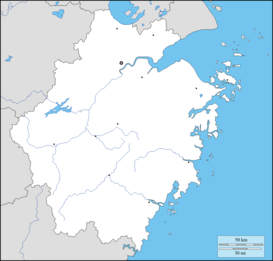geo.wikisort.org - Embalse
El lago del Oeste (en chino tradicional, 西湖; pinyin, xī hú; literalmente, ‘lago del Oeste’), es un histórico lago situado en el centro de Hangzhou. Es famoso por sus paisajes, y por su patrimonio cultural. Hay pabellones, pagodas, jardines y muchos edificios históricos dispersos por las orillas de todo el lago.
| Paisaje cultural del Lago del Oeste en Hangzhou | ||
|---|---|---|
|
Patrimonio de la Humanidad de la Unesco | ||
 Vistas del Lago del Oeste. | ||
 Paisaje cultural del Lago del Oeste en Hangzhou Ubicación en Zhejiang. | ||
| País |
| |
| Datos generales | ||
| Tipo | Cultural | |
| Criterios | ii, iii, vi | |
| Identificación | 1334 | |
| Región | Asia y Oceanía | |
| Inscripción | 2011 (XXXV sesión) | |
El paisaje cultural del Lago del Oeste de Hangzhou ha sido nombrado Patrimonio de la Humanidad por la Unesco en 2011, debido a que "ha inspirado a famosos poetas, pensadores y artistas desde el siglo IX. Alberga numerosos templos, pagodas, pabellones, jardines, árboles ornamentales, así como un paso elevado e islas artificiales. [...] El Lago del Oeste ha influido el diseño de jardines en el resto de China así como en Japón y Corea durante siglos y muestra un excepcional testimonio de la tradición cultural paisajística creando una serie de vistas que reflejan la fusión idealizada entre el hombre y la naturaleza."[1]
Patrimonio arquitectónico
Del patrimonio arquitectónico y cultural del Lago del Oeste podemos destacar:
- Templo de Yue Fei (岳王廟), tumba y templo conmemorativo a Yue Fei (岳飛).
- Templo de Lingyin (靈隱寺), monasterio budista.
- Granjas de té Longjing (龍井茶園), zona conocida por la calidad de sus plantaciones de té.
- Templo de Jingci.
- Manantial del Tigre Galopante (虎跑夢泉), manantial famoso por sus aguas minerales.
- Tumba de Su Xiao Xiao (蘇小小墓)
- Tumba de Wu Song (武松墓)
- El Museo del Lago del Oeste (ubicado en su orilla) está dedicado al patrimonio cultural del lago.
- Diferentes pagodas: Pagoda Leifeng, Pagoda Baochu y Pagoda Liuhe.
Véase también
- Jardín botánico de Hangzhou
Referencias
Enlaces externos
 Wikimedia Commons alberga una categoría multimedia sobre Lago del Oeste.
Wikimedia Commons alberga una categoría multimedia sobre Lago del Oeste.
На других языках
[de] Westsee
Der Westsee (chinesisch .mw-parser-output .Hani{font-size:110%}西湖, Pinyin Xī Hú) bei der Stadt Hangzhou in Zhejiang ist eine der größten Touristenattraktionen der Volksrepublik China. Eine lokale Bezeichnung lautet Xīzǐ Hú (西子湖) in Anlehnung an Xīzǐ (西子), eine der Vier Schönheiten des Altertums. Seit 2011 ist die Kulturlandschaft um den Westsee als UNESCO-Welterbe gelistet.[1][en] West Lake
West Lake (Chinese: 西湖; Wu Chinese: [si ɦu]) is a freshwater lake in Hangzhou, China. It is divided into five sections by three causeways. There are numerous temples, pagodas, gardens, and natural/artificial islands within the lake. Gushan (孤山) is the largest natural island and three artificial islands: Xiaoyingzhou (小瀛洲), Huixin Pavilion (湖心亭), and Ruan Gongdun (阮公墩) stand at the middle of the lake. Leifeng Pagoda (雷峰塔) and Baochu Pagoda (保俶塔) are separated by the lake. Mirroring each other, the basic pattern of "one mountain, two towers, three islands, three banks, and five lakes" is formed.- [es] Lago del Oeste
[ru] Сиху
Сиху́ (кит. упр. 西湖, пиньинь Xī Hú, букв. «Западное озеро») — знаменитое пресноводное озеро в центре города субпровинциального значения Ханчжоу провинции Чжэцзян Китайской народной республики. Озеро пересекают дамбы Суди (кит. упр. 蘇堤, пиньинь Sū Dī, «Дамба Су Дунпо»), Боди (кит. упр. 白堤, пиньинь Bái Dī, «Дамба Бо Цзюйи») и Янгунди (кит. упр. 楊公堤, пиньинь Yánggōng Dī ). 24 июня 2011 года озеро Сиху с окрестными храмами, мостами и садами было внесено ЮНЕСКО в список Всемирного наследия.[1]Другой контент может иметь иную лицензию. Перед использованием материалов сайта WikiSort.org внимательно изучите правила лицензирования конкретных элементов наполнения сайта.
WikiSort.org - проект по пересортировке и дополнению контента Википедии